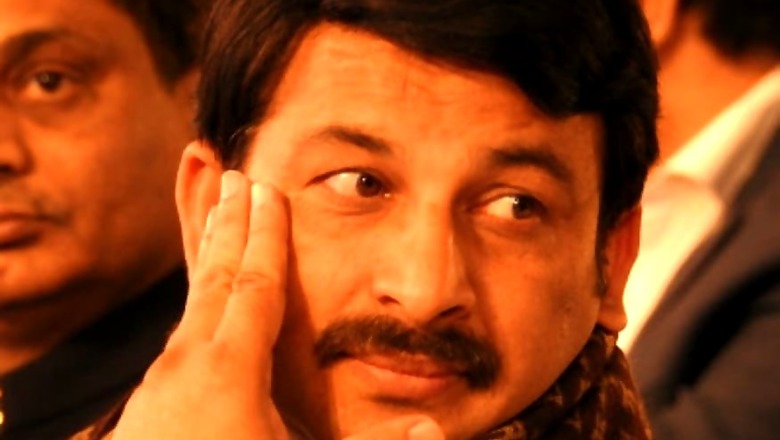
views
The loss of the Bharatiya Janata Party at the hands of the Aam Aadmi Party (AAP) in the Delhi Assembly elections held in February this year, made two very clear conclusions – one that BJP Delhi unit president Manoj Tiwari failed to enthuse the substantial migrant voters and also that the saffron party lost its traditional Vaishya (Baniya) vote to the rival party.
In what was almost a bipolar poll, the BJP should have ordinarily romped home had the party’s Vaishya vote base gone with it. They instead opted for a Baniya-led AAP and almost all Vaishya dominated seats with the exception of Rohini went to the AAP. The Rohini seat was won with much difficulty by former Delhi BJP president Vijender Gupta, a Baniya himself.
Probably these factors weighed heavily on the minds of party top honchos while appointing municipal councillor and former Mayor Adesh Kumar Gupta as its Delhi unit president. The new party president, however, is a Baniya of a different genre. Unlike the traditional Baniyas of Delhi, who trace their roots to Haryana, Punjab and Rajasthan, Gupta is from Kannauj in central Uttar Pradesh. The task he has at hand is to win the municipal elections scheduled for April 2022.
Caste and community combinations aside, another major factor which contributed to the defeat of the BJP in Delhi was absence of a face to match the appeal of Kejriwal. Manoj Tiwari remained party president for almost four years but could never rise beyond his image of a Bhojpuri singer who could win polls regaling audiences with rendition of his lewd songs which at times bordered to being vulgar.
Tiwari’s appointment as Delhi unit president in itself was surprising. Till his appointment, the Delhi unit of the BJP had been looked after by the people who had a firm grounding in the Rashtriya Swayamsewak Sangh (RSS) and had qualified from the ranks of the Akhil Bharatiya Vidyarthi Parishad (ABVP) or other frontal orgnaisations.
Whereas Tiwari is a political fortune seeker. He first gave aperture to his political ambitions by contesting against Uttar Pradesh chief minister Yogi Adityanath getting badly bruised in battle for Gorakhpur during the 2009 Lok Sabha polls. Thereafter, he sought refuge in Delhi Congress ahead of the 2013 Vidhan Sabha polls. He finally found refuge in the BJP, which was looking for a suitable Poorvanchali face to counter AAP’s Anand Kumar on the North East Delhi during the 2014 Lok Sabha polls.
Winning a poll on a Bharatiya Janata Party (BJP) ticket for a political fortune seeker could have been easy but to be leading a party unit against a rival party led by a smartly manoeuvring Arvind Kejriwal proved to be insoluble. The advocates of Manoj Tiwari would point to the victories of the party under his stewardship in the 2017 municipal corporations of Delhi (MCsD) polls and 2019 Lok Sabha polls.
These arguments are not more than a delusion. In 2017, the credit for the BJP managing to retain the MCsD should go to a rejuvenated Congress under then Delhi unit president Ajay Maken, who managed to raise the party’s vote share from a meagre 9 percent in 2015 Vidhan Sabha polls to a very respectable 22 percent in the municipal polls.
The BJP in 2017 municipal polls had just about managed to retain its traditional vote share of about 35 percent, however, came to rule the MCsD as the opposition vote share was divided between the Congress and the AAP. The sole credit for the 2019 Lok Sabha polls would always be given to the poll machinery put in place by then national unit president Amit Shah.
However, 2020 Delhi Vidhan Sabha polls gave a rap on the knuckles of Amit Shah, who had put his heart and soul in the elections. The absence of a workable party machinery proved to be BJP’s undoing. Shah tried to overcome it with a blitzkrieg, which was undid by the Vaishya voters shifting base to the AAP. BJP could have countered this with the migrant voters but Tiwari was unable to make any real time inroads among the politically conscious and ambitious Poorvanchali/Bihari electorate.
Despite the fact that the Vaishyas dominate the local organisation of the RSS, the Baniya voters of Delhi had been annoyed for some time with the BJP after the Narendra Modi-Amit Shah duo gave a short shrift to current Union Health Minister Harshvardhan. The amiable doctor was party’s face in 2013 assembly polls when the BJP emerged as the largest party in the assembly, and went onto win all the seven seats during the 2014 Lok Sabha polls, from zero seats in 2009.
Harshvardhan was appointed as Health Minister in the first Modi cabinet but soon downgraded and given relatively innocuous ministries. Even at the organisation level, the Banias were largely ignored. Though Vardhan was reinstated as Health Minister in Modi 2.0 government, he was not projected as Chief Ministerial candidate.
As the poll campaign progressed Tiwari had the mantle of Chief Ministerial face, albeit informally, thrust upon himself. This somewhere had the backing of the campaign managers for they thought that it could garner the migrant votes. That did not happen, and the BJP in the bargain also lost its Baniya vote bank to the AAP.
The chances of Adesh Kumar Gupta being a rival to Kejriwal is almost remote. However, his lack of charisma could be overcome by experience in the organisation and being from a traditionally BJP-supporting community. Last time around Congress had done well to cut into the AAP’s vote share. The same may or may not happen in 2022 as the reigns of the grand old party in Delhi is in a relatively ‘inexperienced’ hand. That would make Gupta’s job more challenging.
(The writer is a senior journalist and political analyst. Views expressed are personal.)




















Comments
0 comment